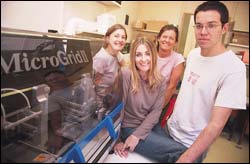New facility boosts research in gene expression
03 May 2004
The capar team includes (from left) Dr Katherine Denby, Sally-Ann Walford, Prof Nicci Illing and Nicolas Immelman.
A new, affordable microarray service, capar (cape array opportunities) has been launched in the molecular and cell biology department, designed to boost research capacity among South African specialists in gene expression, in fields from human health to plant biotechnology. It is one of only two facilities on the continent and the only one to offer full microarray services, a welcome development for African researchers.
capar is a technology platform supported by the Cape Biotech Trust (CBT), one of the regional biotechnology centres set up by government. The equipment base was bought with funds from the Innovation Fund, the National Research Foundation (NRF) and UCT, while CBT has given capar a grant to employ staff for 18 months.
The directors are the department's Professor Nicci Illing and Dr Katherine Denby. Sally-Ann Walford, the "full-time fundi", thanks to funds from the Cape Biotech Trust, is the senior scientific officer. A technical officer is being appointed. Two second-year students, Nicolas Immelman and Johan van Heerden, are installing the software platform for the handling of the masses of gene expression data generated in microarray experiments.
capar is equipped with a Biorobotics Arrayer capable of printing at high-density on standard glass slides. An Axon dual-laser scanner is used to detect and capture hydridisation signals, while Geneopix analysis software processes the data. The combination provides excellent quality - high-density spot morphology, clear round spots that enable researchers to detect which genes are "on or off".
The new research platform can be used in a variety of fields, assisting researchers in human and animal health, plant biotechnology and industrial bioprocessing. Already, some "big achievements" have been chalked up using microarray technology: large cDNA clone sets have been effectively amplified and purified for use as probe DNA; successful prints have been made of high-density cDNA and oligonucleotide arrays for several model organisms including Mycobacterium tuberculosis, Arabidopsis thaliana and mouse; and RNA extracted from yeast, plant and animal tissue has been successfully labelled and hybridised.
The colourful launch (the yellow, green and red colours of the microarray dots were copied in the food and drinks) was attended by a throng of users from across the Western Cape with guests from Pretoria and Wits universities.
The function also coincided with a workshop on microarray analysis organised by the National Bioinformatics Network (NBN). Two high-profile specialists in the area, Dr John Quakenbush and Dr Roger Bumgarner, were on hand to launch the sophisticated facility. Both Quackenbush and Bumgarner emphasised the importance of capar as a South African microarray facility, providing a high quality service and allowing local researchers to use the latest gene discovery tools at an affordable cost. At capar, researchers can have slides custom printed and cDNA clones amplified.
 This work is licensed under a Creative Commons Attribution-NoDerivatives 4.0 International License.
This work is licensed under a Creative Commons Attribution-NoDerivatives 4.0 International License.
Please view the republishing articles page for more information.










